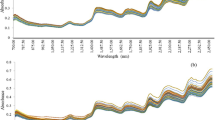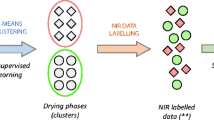Abstract
Blackheart and soluble solids content (SSC) are critical parameters of pear for quality assessment and export trade guarantee. A non-destructive detection method was developed for measuring blackheart pear and SSC. Three discriminate analysis models, such as principal component analysis (PCA), correlation analysis and partial least square discriminate analysis (PLS-DA), were developed to identify black heart samples. Compared with PCA and correlation analysis, PLS-DA achieved the highest classification accuracy of 100% for identifying blackheart pears. Three sample sets of healthy samples, black heart ones, and their combination were applied to assess the performance of PLS model, and PLS model calibrated with healthy pears yielded better with root-mean-square errors of prediction 0.45°Brix. The overall results suggested that it was feasible to detect blackheart and SSC of pears simultaneously by online visible–NIR spectroscopy.





Similar content being viewed by others
References
Sun X, Liu Y, Li Y et al (2016) Simultaneous measurement of brown core and soluble solids content in pear by on-line visible and near infrared spectroscopy. Postharvest Biol Technol 116:80–87
Serra S, Musacchi S (2018) Postharvest dry matter and soluble solids content prediction in d’Anjou and Bartlett pear using near-infrared spectroscopy. HortScience 53:669–680
Luo X, Ye Z, Xu H et al (2018) Robustness improvement of NIR-based determination of soluble solids in apple fruit by local calibration. Postharvest Biol Technol 139:82–90
Arendse E, Fawole OA, Magwaza LS et al (2018) Evaluation of biochemical markers associated with the development of husk scald and the use of diffuse reflectance NIR spectroscopy to predict husk scald in pomegranate fruit. Sci Hortic 232:240–249
Malegori C, Marques EJN, de Freitas ST et al (2017) Comparing the analytical performances of Micro-NIR and FT-NIR spectrometers in the evaluation of acerola fruit quality, using PLS and SVM regression algorithms. Talanta 165:112–116
Viegas TR, Mata ALML, Duarte MML et al (2016) Determination of quality attributes in wax jambu fruit using NIRS and PLS. Food Chem 190:1–4
Arendse E, Fawole OA, Magwaza LS et al (2018) Fourier transform near infrared diffuse reflectance spectroscopy and two spectral acquisition modes for evaluation of external and internal quality of intact pomegranate fruit. Postharvest Biol Technol 138:91–98
Nordey T, Joas Davrieux F et al (2017) Robust NIRS models for non-destructive prediction of mango internal quality. Sci Hortic 216:51–57
Munera S, Amigo JM, Blasco J et al (2017) Ripeness monitoring of two cultivars of nectarine using VIS–NIR hyperspectral reflectance imaging. J Food Eng 214:29–39
Escribano S, Biasi WV, Lerud R et al (2017) Non-destructive prediction of soluble solids and dry matter content using NIR spectroscopy and its relationship with sensory quality in sweet cherries. Postharvest Biol Technol 128:112–120
Munera S, Amigo JM, Aleixos N et al (2018) Potential of VIS–NIR hyperspectral imaging and chemometric methods to identify similar cultivars of nectarine. Food Control 86:1–10
Acknowledgements
The authors gratefully acknowledge the financial support provided by Jiangxi Outstanding Youth Talent Program (20171BCB23060) and Jiangxi Provincial Education Department Project (GJJ160478).
Author information
Authors and Affiliations
Corresponding author
Rights and permissions
About this article
Cite this article
Sun, X., Zhu, K., Jiang, X. et al. Non-destructive detection of blackheart and soluble solids content of intact pear by online NIR spectroscopy. J Supercomput 76, 3173–3187 (2020). https://doi.org/10.1007/s11227-018-2537-9
Published:
Issue Date:
DOI: https://doi.org/10.1007/s11227-018-2537-9




